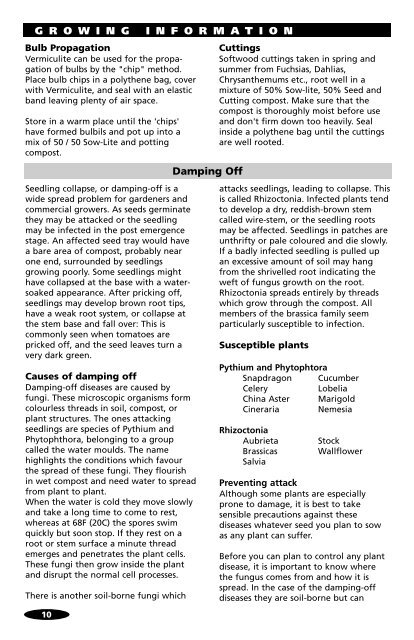Seed Guide 2007 pgs 01/41 - McKenzie Seeds
Seed Guide 2007 pgs 01/41 - McKenzie Seeds
Seed Guide 2007 pgs 01/41 - McKenzie Seeds
Create successful ePaper yourself
Turn your PDF publications into a flip-book with our unique Google optimized e-Paper software.
G R O W I N G I N F O R M A T I O N<br />
Bulb Propagation<br />
Vermiculite can be used for the propagation<br />
of bulbs by the "chip" method.<br />
Place bulb chips in a polythene bag, cover<br />
with Vermiculite, and seal with an elastic<br />
band leaving plenty of air space.<br />
Store in a warm place until the 'chips'<br />
have formed bulbils and pot up into a<br />
mix of 50 / 50 Sow-Lite and potting<br />
compost.<br />
<strong>Seed</strong>ling collapse, or damping-off is a<br />
wide spread problem for gardeners and<br />
commercial growers. As seeds germinate<br />
they may be attacked or the seedling<br />
may be infected in the post emergence<br />
stage. An affected seed tray would have<br />
a bare area of compost, probably near<br />
one end, surrounded by seedlings<br />
growing poorly. Some seedlings might<br />
have collapsed at the base with a watersoaked<br />
appearance. After pricking off,<br />
seedlings may develop brown root tips,<br />
have a weak root system, or collapse at<br />
the stem base and fall over: This is<br />
commonly seen when tomatoes are<br />
pricked off, and the seed leaves turn a<br />
very dark green.<br />
Causes of damping off<br />
Damping-off diseases are caused by<br />
fungi. These microscopic organisms form<br />
colourless threads in soil, compost, or<br />
plant structures. The ones attacking<br />
seedlings are species of Pythium and<br />
Phytophthora, belonging to a group<br />
called the water moulds. The name<br />
highlights the conditions which favour<br />
the spread of these fungi. They flourish<br />
in wet compost and need water to spread<br />
from plant to plant.<br />
When the water is cold they move slowly<br />
and take a long time to come to rest,<br />
whereas at 68F (20C) the spores swim<br />
quickly but soon stop. If they rest on a<br />
root or stem surface a minute thread<br />
emerges and penetrates the plant cells.<br />
These fungi then grow inside the plant<br />
and disrupt the normal cell processes.<br />
There is another soil-borne fungi which<br />
10<br />
Damping Off<br />
Cuttings<br />
Softwood cuttings taken in spring and<br />
summer from Fuchsias, Dahlias,<br />
Chrysanthemums etc., root well in a<br />
mixture of 50% Sow-lite, 50% <strong>Seed</strong> and<br />
Cutting compost. Make sure that the<br />
compost is thoroughly moist before use<br />
and don't firm down too heavily. Seal<br />
inside a polythene bag until the cuttings<br />
are well rooted.<br />
attacks seedlings, leading to collapse. This<br />
is called Rhizoctonia. Infected plants tend<br />
to develop a dry, reddish-brown stem<br />
called wire-stem, or the seedling roots<br />
may be affected. <strong>Seed</strong>lings in patches are<br />
unthrifty or pale coloured and die slowly.<br />
If a badly infected seedling is pulled up<br />
an excessive amount of soil may hang<br />
from the shrivelled root indicating the<br />
weft of fungus growth on the root.<br />
Rhizoctonia spreads entirely by threads<br />
which grow through the compost. All<br />
members of the brassica family seem<br />
particularly susceptible to infection.<br />
Susceptible plants<br />
Pythium and Phytophtora<br />
Snapdragon Cucumber<br />
Celery Lobelia<br />
China Aster Marigold<br />
Cineraria Nemesia<br />
Rhizoctonia<br />
Aubrieta Stock<br />
Brassicas Wallflower<br />
Salvia<br />
Preventing attack<br />
Although some plants are especially<br />
prone to damage, it is best to take<br />
sensible precautions against these<br />
diseases whatever seed you plan to sow<br />
as any plant can suffer.<br />
Before you can plan to control any plant<br />
disease, it is important to know where<br />
the fungus comes from and how it is<br />
spread. In the case of the damping-off<br />
diseases they are soil-borne but can


